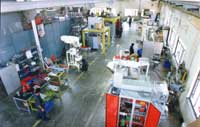Nichrome launches aseptic pouch packaging machine
31 Oct 2000
The concept of aseptic packaging is  not new in the country, but most of it has been of the carton variety. "Carton packaging is more expensive. Aseptic pouch packaging, on the other hand, makes the technology far more affordable to the end user," says Mr. S V Joshi, managing director, Nichrome India.
not new in the country, but most of it has been of the carton variety. "Carton packaging is more expensive. Aseptic pouch packaging, on the other hand, makes the technology far more affordable to the end user," says Mr. S V Joshi, managing director, Nichrome India.
Nichrome cannot claim the status of being a pioneer to introduce the concept of aseptic pouches into the country. Tetra Pak brought it in a small way last year, under the brand, 'tetra fino', which, for cost reasons, did not take off. Normal packaging material consists of a single layered plastic, while aseptic packaging comes in layers of polymer, aluminium foil and LDPE, which adds to the packaging cost.
According to Mr. Joshi, the indigenous technology makes aseptic pouch packing an affordable alternative. "Our machines bring down the cost to such an extent that milk sold in these packs can be sold at the rate of pasteurised milk," he says.
Milk packed in aseptic packaging is given the UHT treatment -- heated to a temperature of 140 degrees centigrade, and then brought down to 25 degrees, which gives it longer shelf life at room temperature. In pasteurising, milk is heated to 70 to 80 degrees, which limits its shelf life considerably, and requires refrigeration.
 The product is marketed as 'value added packaging'. "Aseptic packing does away with the need for cold storage, cold chain transition, or refrigerated points of sale. Therefore it becomes possible for producers to go in for a wider distribution radius," says Mr. Joshi.
The product is marketed as 'value added packaging'. "Aseptic packing does away with the need for cold storage, cold chain transition, or refrigerated points of sale. Therefore it becomes possible for producers to go in for a wider distribution radius," says Mr. Joshi.
Needless to say, his primary target is the dairy industry where, he believes, the product can have tremendous value addition. "The dairy industry operates between lean and flush seasons. During the flush seasons milk is converted into powder, using energy, and then again it is reconverted to milk during the lean season. With aseptic packaging, this conversion and re-conversion can be done away with. The milk producer also has the option of sending the milk out to a greater distance where milk availability is low. He could not do it with ordinary pasteurised milk, it being a perishable product. The longer shelf life through aseptic packaging allows him to send the milk further out over a greater distance."





















